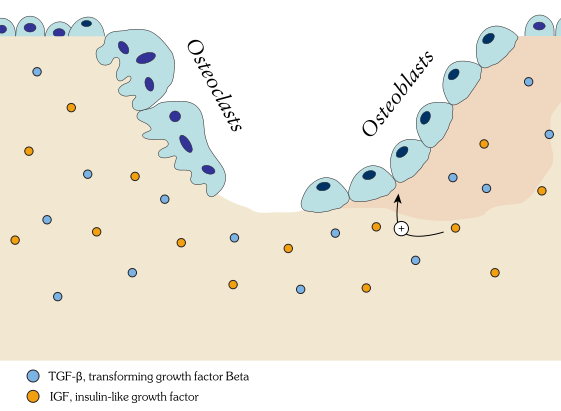30.2A: Stages of Bone Development
- Page ID
- 8415
Although bone initially forms during fetal development, it undergoes secondary ossification after birth and is remodeled throughout life.
- Describe the process and purpose of bone remodeling
Key Points
- The formation of bone during the fetal stage of development occurs by two processes: intramembranous ossification and endochondral ossification.
- Secondary ossification occurs after birth and forms the epiphyses of long bones and the extremities of irregular and flat bones.
- After initial bone development, bones are remodeled throughout life to regulate calcium homeostasis and repair micro-damaged bones (from everyday stress ), as well as to shape the skeleton during growth.
Key Terms
- diaphysis: The central shaft of any long bone.
- epiphyses: The rounded ends of a long bone at its joint with adjacent bone(s).
EXAMPLES
When a tooth is lost and not replaced, bone remodeling will fill in much of the socket. Although the remodeling will be obvious within a few weeks (especially when smiling), the process will continue for some months.
Bones are rigid organs that constitute part of the endoskeleton of vertebrates. They support and protect the various organs of the body, produce red and white blood cells, and store minerals. Bone tissue is a type of dense connective tissue that appears static, but is actually constantly remodeled throughout the life of the vertebrate organism. This occurs with the synchronized action of osteoclasts and osteoblasts, cells that reabsorb and deposit bone, respectively. Bone remodeling also occurs in response to trauma, such as following an accidental fracture or placement of dental implants.
Initial Bone Formation
The formation of bone during the fetal stage of development occurs by two processes: intramembranous ossification and endochondral ossification.
Intramembranous Ossification
Intramembranous ossification mainly occurs during the formation of the flat bones of the skull, as well as the mandible, maxilla, and clavicles. The bone is formed from connective tissue such as mesenchyme tissue rather than from cartilage. The steps in intramembranous ossification are:
- Development of ossification center
- Calcification
- Formation of trabeculae
- Development of periosteum
Endochondral Ossification
Endochondral ossification begins with points in the cartilage called “primary ossification centers.” They mostly appear during fetal development, though a few short bones begin their primary ossification after birth. These cartilage poitns are responsible for the formation of the diaphyses of long bones, short bones, and certain parts of irregular bones.
Secondary ossification occurs after birth and forms the epiphyses of long bones and the extremities of irregular and flat bones. The diaphysis and both epiphyses of a long bone are separated by a growing zone of cartilage (the epiphyseal plate). When the child reaches skeletal maturity (18 to 25 years of age), all cartilage is replaced by bone, fusing the diaphysis and both epiphyses together (epiphyseal closure).
Remodeling
Remodeling or bone turnover is the process of resorption followed by replacement of bone with little change in shape, and occurs throughout a person’s life, long beyond the initial development of bone. Osteoblasts and osteoclasts, coupled together via paracrine cell signalling, are referred to as a bone remodeling unit. Approximately 10% of the skeletal mass of an adult is remodeled each year.
The bone remodeling period consists of the duration of the resorption, the osteoclastic reversal (the phase marked by shifting of resorption processes into formative processes), and the formation periods of bone growth and development. The bone remodeling period refers to the average total duration of a single cycle of bone remodeling at any point on a bone surface.
The purpose of remodeling is to regulate calcium homeostasis and repair micro-damage from everyday stress, as well as to shape the skeleton during growth. Repeated stress, such as weight-bearing exercise or bone healing, results in the bone thickening at the points of maximum stress (Wolff’s law).

Osteoclasts and Osteoblasts: Bone tissue is removed by osteoclasts, and then new bone tissue is formed by osteoblasts. Both processes utilize cytokine (TGF-β, IGF) signalling.

